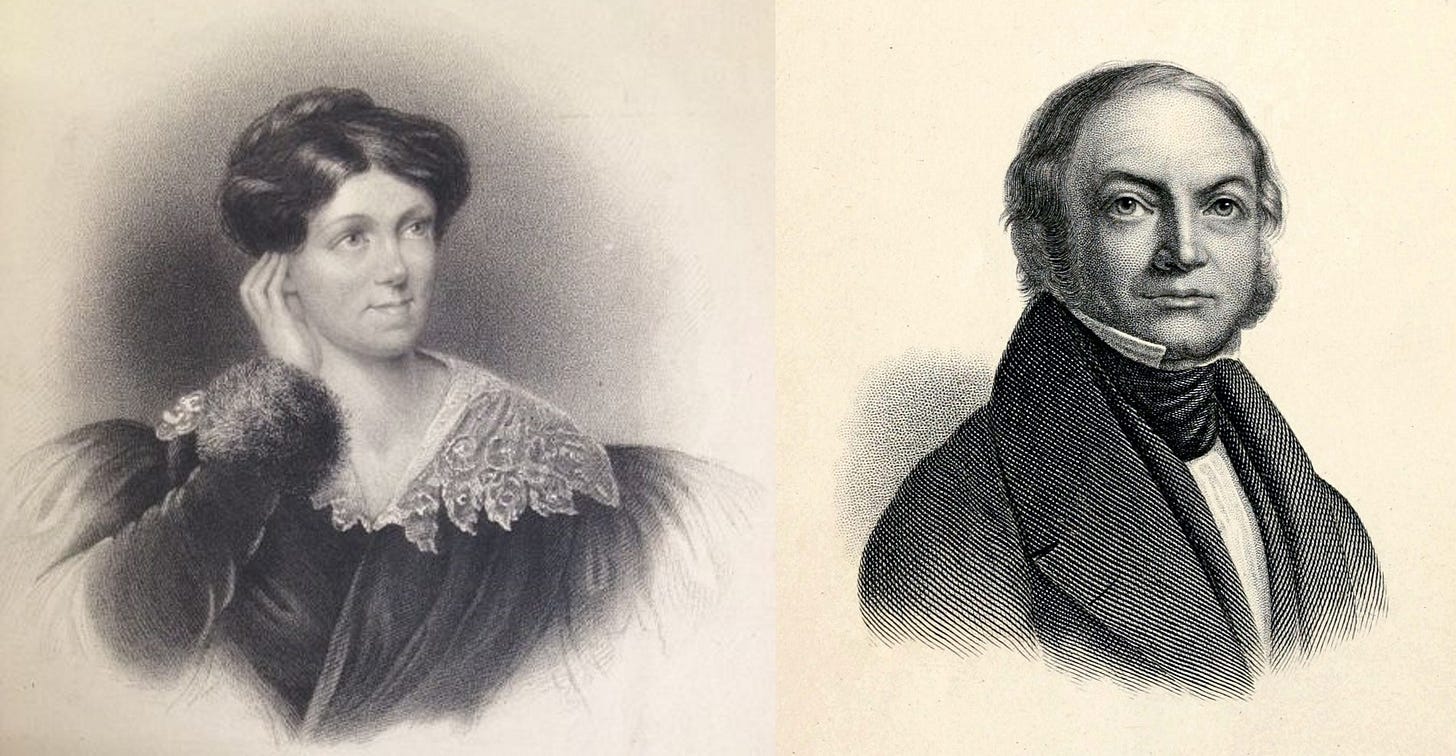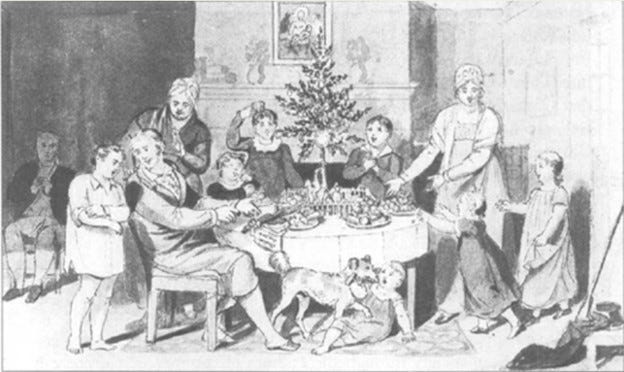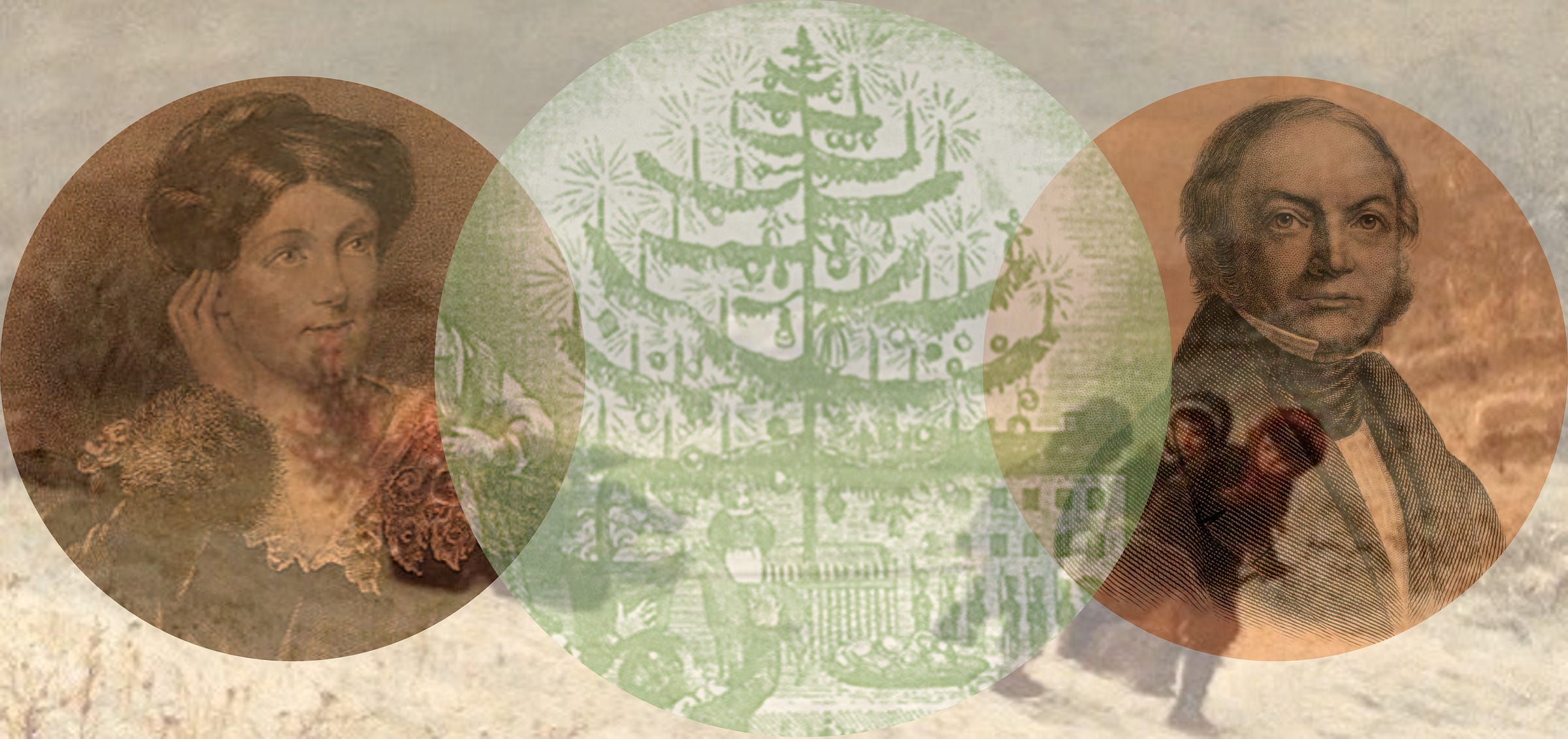Hello Interactors,
[This is a repost from last Christmas eve. It’s a great story worthy of another share!]
For all you Christmas celebrators out there, happy Christmas Eve. Since many will be gathering ‘round a Christmas tree, I thought I’d tell the story of its origin. And like so much of American history, it has ties to immigrants and slavery; but in this case — anti-slavery.
As interactors, you’re special individuals self-selected to be a part of an evolutionary journey. You’re also members of an attentive community so I welcome your participation.
Please leave your comments below or email me directly.
Now let’s go…
A TREE SO YEE MAY BE FREE
“If the morning drives are extended beyond the city, there is much to delight the eye. The trees are eased in ice; and when the sun shines out suddenly, the whole scene looks like one diffused rainbow,—dressed in a brilliancy which can hardly be conceived of in England. On days less bright, the blue harbour spreads in strong contrast with the sheeted snow which extends to its very brink.”1
These are the words of Harriet Martineau. She was a English writer, journalist, and social theorist who pioneered observational methods that came to influence the field of sociology. One of her more popular books came at the end of her travels through the United States in the 1830s titled, Retrospect of Western Travel. The passage above describes what she saw as she left the Boston city limits in the snow the winter of 1835.
You may have images of her bundled up in a one horse open sleigh, over the hills she went, dashing all the way. But according to Martineau, you can let go of any such romantic inclinations. Here’s her take on sleighing.
“As for the sleighing, I heard much more than I experienced of its charms. No doubt early association has something to do with the American fondness for this mode of locomotion; and much of the affection which is borne to music, dancing, supping, and all kinds of frolic, is transferred to the vehicle in which the frolicking parties are transported. It must be so, I think, or no one would be found to prefer a carriage on runners to a carriage on wheels,—except on an untrodden expanse of snow. On a perfectly level and crisp surface I can fancy the smooth rapid motion to be exceedingly pleasant; but such surfaces are rare in the neighbourhood of populous cities. The uncertain, rough motion in streets hillocky with snow, or on roads consisting for the season of a ridge of snow with holes in it, is disagreeable, and provocative of headache. I am no rule for others as to liking the bells; but to me their incessant jangle was a great annoyance.”2
And if that’s not enough to convince you, she offers up a quote from unknown source that puts a finer touch on the realities of sleighing.
“Do you want to know what sleighing is like? You can soon try. Set your chair on a spring board out in the porch on Christmas-day: put your feet in a pail full of powdered ice: have somebody to jingle a bell in one ear, and somebody else to blow into the other with the bellows,—and you will have an exact idea of sleighing.”3
Martineau was on her way to a Christmas evening celebration at the home of a former Harvard German language professor, Charles Follen. Although, due to scheduling conflicts the event was actually on New Years Eve and not Christmas Eve. The cozy holiday scene that Martineau proceeds to unfold came to be the most, though not the first, read articulation of what came to be the center piece of American Christmas celebration – the Christmas tree.

Follen was a German immigrant so perhaps it’s not that surprising that a Christmas tree would feature prominently in her story. It’s been a long held belief that German immigrants brought their time-honored Christmas tree tradition with them. Though, as we’ll soon see, the evolution of the Christmas tree tradition in America paralleled that of Germany.
Martineau’s account of that evening, while factual, leaves out important historical details as to why she was celebrating Christmas with Follen and his family that night. These were two radical Unitarian abolitionists who bonded over their insistence that slavery be eradicated totally and immediately. Northerner’s, and New England Unitarians, were split on the matter of abolition. Follen’s convictions are what got him fired from Harvard a year prior.
As for Martineau, she was a well known and respected journalist but not yet a public activist. But after attending a women’s abolitionist meeting that November, she was convinced she needed to act. She was asked at that meeting to write publicly avowing her beliefs. Being one of the only women writers of her time to sustain herself through writing and still requiring access to America’s mainstream elite for her book, she faced an ethical dilemma.
Later she wrote, “I foresaw that almost every house in Boston, except those of the abolitionists, would be shut against me; that my relation to the country would be completely changed, as I should suddenly be transformed from being a guest and an observer to being considered a missionary or a spy.…”4
News leaked of her position on slavery and Boston newspapers ridiculed her. Their headlines spread across the country and she was forced to alter her itinerary. The event she was attending at Follen’s home wasn’t just a Christmas celebration, but an anti-slavery strategy session. That spring, she (in the company of Charles Follen) took to the road not as journalist, but as an activist.
CHRISTKINDLE AND BELSNICKEL
Historians and folklorists have determined that the first Christmas tree in America was most likely in the home of a German immigrant in Pennsylvania. But it’s unlikely to have occurred anytime before 1810. The first known sketch of a family celebrating Christmas, featuring a small tree atop a table, was not printed until recent decades but dates to either 1812 or 1819.

Recall from my November posts on the origins of Thanksgiving, this was also the time when St. Nicholas was also entering the picture in New York. The Christmas tree tradition was also just emerging in Germany at this very same time. The Christmas tree, like Santa Claus himself, wasn’t a long held German tradition but a story told by a select group of elites who latched on to a small, isolated, and obscure holiday event that was occurring in what was then Strasbourg, Germany but is now part of France.
It was established sometime in the 17th century as a quasi-religious way of judging children on the basis of them being naughty or nice. If you were nice you got a visit that night from Christkindle (i.e. the Christchild) and if you were naughty you got a visit from Hanstrapp; Strasbourg’s equivalent of what became known as Belsnickle (roughly translated: St. Nicholas in Fur).
This character has echo’s of behavior seen by Wassailers during Thanksgiving celebrations where men, often of lower class, would dress up and go door to door, often times even welcoming themselves in. Perhaps this offers a clue into how Santa became a home invader. Though, should Belsnickle determine a child in the home had been naughty, he gifted the parents with a stick with instructions to whip the poor child.
The Christmas tree tradition expanded beyond Strasbourg around 1750. Its spread may have been accelerated by a young up and coming writer, naturalist, and scientist, Johann Wolfgang von Goethe in 1771. Recall from my October post, that by the dawn of the 18th century Goethe had established himself as the go-to guy by the German government for writing, organizing, and evangelizing his opinions and observations on everything from gardening, to parks management, to economics.
He had spent some time in Strasbourg and “discovered in this city a new sense of “German” identity that transformed his larger cultural vision.” His 1774 novel, The Sufferings of Young Werther, is a story of a love triangle that ends tragically. And in the lead up to this tragedy, Goethe writes how young Werther “spoke of the pleasure the children would feel and remembered how in times long past he had himself been transported to paradise by the surprise opening of a door and the appearance of the decorated tree with its candles, sweets, and apples.”5
It wasn’t until 1810 that the Christmas Tree tradition made it’s way to Berlin. It was introduced in Munich in 1830 by the Queen of Bavaria. Goethe had inspired a string of writers publishing stories of Christmas trees that were disseminated throughout Europe and the United States. And it was all happening at the same time of the first recorded evidence of a Christmas tree in America – 1820.
And then, in 1836, came the first printed image of a Christmas tree in America. It was titled “Christmas Eve” and was featured in a story called The Stranger’s Gift. It was written, as you might expect, by a German immigrant. But not just any German immigrant. It was written by Herman Bokum, the professor who replaced Follen after Harvard let him go for his public opposition to slavery just one year earlier.

YOUR BOUGHS CAN TEACH A LESSON
After Follen lost his job at Harvard he was hired by a family to home school their two children. Follen strictly followed a progressive teaching method derived from a Swiss educational reformer named Johann Pestalozzi. Pestalozzi had a child-centered and directed educational philosophy. He believed every child is born with inherently good qualities and it’s the teachers role to find them and cultivate them. It’s unclear whether Follen’s enemies convinced the family to reconsider, the family themselves had a change of heart, or Follen, ever dogmatic in his principles, refused to budge on his teaching approach, but two weeks before Christmas of 1835 he was terminated.
It is in this context that Harriett Martineau attended the Christmas celebration in Follen’s newly built home on the corner of Follen Avenue outside of Boston. Martineau did not mention Follen by name in her retelling of their Christmas tree celebration, only Follen’s son who everyone called “Little Charley.” She writes,
“I was present at the introduction into the new country of the spectacle of the German Christmas-tree. My little friend Charley, and three companions, had been long preparing for this pretty show…I rather think it was, generally speaking, a secret out of the house; but I knew what to expect…The tree was the top of a young fir, planted in a tub, which was ornamented with moss. Smart, dolls, and other whimsies, glittered in the evergreen; and there was not a twig; which had not something sparkling upon it… Charley looked a good deal like himself, only now and then twisting himself about in an unaccountable fit of giggling. I mounted the steps behind the tree to see the effect of opening the doors. It was delightful. The children poured in; but in a moment, every voice was hushed. Their faces were upturned to the blaze, all eyes wide open, all lips parted, all steps arrested. Nobody spoke; only Charley leaped for joy.”6
It was two years before Martineau’s book was published. She continued her friendship with Follen until his tragic death in 1841. He was killed when a steamship he was traveling on exploded. His photograph hung on the wall of her home until she died in 1876.
And in the intervening years of her book being published, a writer friend of theirs, Catharine Maria Sedgwick, wrote a fictional story called “New Years Day” that included a brief mention of a Christmas tree celebration akin to what actually took place at the Follens. It was published that same year, 1835, making it the first piece of American literature to mentioned a Christmas tree.
It’s unfortunate America’s Christmas tree origin story doesn’t start with the telling of Charles Follen and Harriett Martineau and their New Years Eve anti-slavery strategy meeting around the Christmas tree. Not only is their relationship full of intrigue, but the idea of the Christmas tree immortalized as an historic symbol of freedom from slavery seems an appropriate American Christmas tale. Perhaps the story of Follen and Martineau is what we should be reading to children every Christmas eve and not just T’was the Night Before Christmas.
Both the story of the Christmas tree as a time-honored German cultural tradition and America’s favorite Christmas time fable, T’was the Night Before Christmas, were largely fabricated and perpetuated by a select group of elites on both sides of the Atlantic.
Clement Clark Moore, the author of T’was the Night Before Christmas, — and his reactionary New York Episcopalian Knickerbocker friends — were interested in imbuing their Christmas tales with aristocratic authority. In contrast, Bollen and his Unitarian Christmas tree literary acquaintances used the Christmas tree to add momentum to the swelling progressive reformist movement of the 1830s.
Stephen Nissenbaum, in his book The Battle for Christmas, explains the similarities between the unfolding of these two events, American traditions, and these two men,
“There were important similarities between the antislavery sensibility and the new attitude toward children. Abolitionists and educational reformers shared a joint empathy for people who were powerless to resist the wrath of those who wielded authority over them—slaves and children, respectively. (Both types of reformers had a particular abhorrence of the use of the lash as a form of punishment.)”7
He continues,
“In fact, what Charles Follen did in 1835 is similar in that sense to what Clement Clarke Moore had done more than a decade earlier, although his reasons—Moore was a reactionary, Follen a radical—were profoundly different. But both men had reason to feel alienated from their respective communities, and both responded by turning inward, to their own children, and using Christmas as the occasion for doing so.”8
And in both cases, literature, and access to it, played a starring role. Nissenbaum, writes,
“As it turns out, the most important channels through which the ritual was spread were literary ones. Information about the Christmas tree was diffused by means of commercial literature, not via immigrant folk culture—from the top down, not from the bottom up. It was by reading about Christmas trees, not by witnessing them, that many thousands of Americans learned about the custom. Before they ever saw such a thing, they already knew what Christmas trees were all about—not only what they looked like, but also how and why they were to be used.”9
It seems another mythical folk tradition is still propagated from the top down more than experienced from bottom up. Recalling Harriet Martineau’s American observation that “As for the sleighing, I heard much more than I experienced of its charms.”
Ibid.
Ibid.
The Battle for Christmas. A Social and Cultural History of Our Most Cherished Holiday. Stephen Nissenbaum. 1997
The Sorrows of Young Werther. Johann Wolfgang von Goethe. 1774.
(1)
(4)
Ibid.
Ibid.










